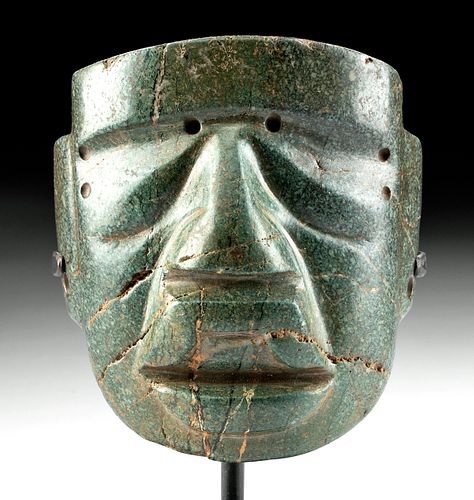Guerrero Mezcala Jadeite Olmecoid Maskette
Lot 104a
About Seller
Artemis Fine Arts
686 S Taylor Ave, Ste 106
Louisville, CO 80027
United States
Selling antiquities, ancient and ethnographic art online since 1993, Artemis Gallery specializes in Classical Antiquities (Egyptian, Greek, Roman, Near Eastern), Asian, Pre-Columbian, African / Tribal / Oceanographic art. Our extensive inventory includes pottery, stone, metal, wood, glass and textil...Read more
Categories
Estimate:
$12,500 - $16,000
Absentee vs Live bid
Two ways to bid:
- Leave a max absentee bid and the platform will bid on your behalf up to your maximum bid during the live auction.
- Bid live during the auction and your bids will be submitted real-time to the auctioneer.
Bid Increments
| Price | Bid Increment |
|---|---|
| $0 | $25 |
| $300 | $50 |
| $1,000 | $100 |
| $2,000 | $250 |
| $5,000 | $500 |
| $10,000 | $1,000 |
| $20,000 | $2,500 |
| $50,000 | $5,000 |
| $100,000 | $10,000 |
| $200,000 | $20,000 |
About Auction
By Artemis Fine Arts
Feb 13, 2020
Set Reminder
2020-02-13 10:00:00
2020-02-13 10:00:00
America/New_York
Bidsquare
Bidsquare : Exceptional Antiquities, Asian, Ethnographic
https://www.bidsquare.com/auctions/artemis-gallery/exceptional-antiquities-asian-ethnographic-4848
An important one-day auction featuring museum-worthy examples of Egyptian, Greek, Roman, Etruscan, Near Eastern, Far East / Asian, Pre-Columbian, African / Tribal, Oceanic, Native American, Spanish Colonial, Russian, Fossils, Ancient Jewelry, Fine Art, so much more! Artemis Fine Arts info@artemisfinearts.com
An important one-day auction featuring museum-worthy examples of Egyptian, Greek, Roman, Etruscan, Near Eastern, Far East / Asian, Pre-Columbian, African / Tribal, Oceanic, Native American, Spanish Colonial, Russian, Fossils, Ancient Jewelry, Fine Art, so much more! Artemis Fine Arts info@artemisfinearts.com
- Lot Description
Pre-Columbian, southern Mexico, Guerrero region, early Mezcala culture, ca. 800 to 400 BCE. A superb example of an abstract anthropomorphic maskette that is expertly hand-carved from mottled forest-green jadeite with light green, dark green, and beige inclusions. The stocky composition is presented with smooth, tall cheeks indicative of an older individual, a broad nose above shallow nasolabial folds, gentle grooves denoting the almond-shaped eyes, and three shallow drilled recesses form the upper profile of the eyelids and brows. The Olmecoid mouth bears a characteristic upturned, puffy lip with a string-cut gap parting the lips, and the tall ears bear a biconically drilled perforation through each lobe. A pair of biconically drilled suspension holes are oriented atop the temples, and the verso is rounded with two vertical 'bangs' draped down the sides. Smooth patina envelops the entire maskette and creates an attractive lustrous presentation. Size: 3.7" W x 3.9" H (9.4 cm x 9.9 cm); 5.4" H (13.7 cm) on included custom stand.
Jade was both rare and prized in the Pre-Columbian world. Carving the stone required expert technique, because jade was the second hardest mineral (the hardest being emery) of Mesoamerica. In order to cut, carve, and drill jade pieces like this, ancient artisans created their own tools that were also made of jade as well as string saws and leather strops. Scholars estimate that it would have taken hours and hours to carve a figure like this.
The Guerrero region of modern-day southwestern Mexico was the center of the Mezcala and Chontal stone carving traditions. While Chontal sculptors imbued their artworks with more naturalism, Mezcala artists were known for their abstract, geometric style. To the Olmecs, however, masks and maskettes like this example carried many meanings, not all of which are obvious to us today. Scholars surmise that the color green was associated with vibrant growth, renewal, and given the cyclical conception of life and death, rejuvenation after death. Although their stonework stems from the Preclassic period, ca. 300 to 100 BCE, later Mesoamerican peoples clearly cherished both Mezcala and Chontal portable sculptures as heirlooms.
Provenance: Howard Rose Gallery, New York, New York, USA; ex-Leonard Kalina Fine Art, Los Angeles, California, USA; ex-Ian Arundel collection, Santa Monica, California, USA, acquired in the 1950s to 1960s
All items legal to buy/sell under U.S. Statute covering cultural patrimony Code 2600, CHAPTER 14, and are guaranteed to be as described or your money back.
A Certificate of Authenticity will accompany all winning bids.
We ship worldwide and handle all shipping in-house for your convenience.
#153077Minor abrasions to face, peripheries, and verso, with a few stable fissures, softening to some finer details, and light encrustations, otherwise intact and excellent. Light earthen deposits and nice patina throughout. Smooth polished surfaces.Condition
- Shipping Info
-
All shipping is handled in-house for your convenience. Your invoice from Artemis Gallery will include shipping calculation instructions. If in doubt, please inquire BEFORE bidding for estimated shipping costs for individual items.
-
- Buyer's Premium



 EUR
EUR CAD
CAD AUD
AUD GBP
GBP MXN
MXN HKD
HKD CNY
CNY MYR
MYR SEK
SEK SGD
SGD CHF
CHF THB
THB














